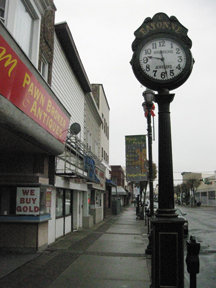For more years than many people can remember, the Abramson’s Jewelers Clock as been a guide.
“People would tell each other to meet at the clock, and everybody knew what it meant,” said Mary Divock, executive director of the Bayonne Town Center Management Corporation, which manages the Special Improvement District where the clock is located. “People look at the clock for the time, and it’s a piece of Bayonne’s history.”
No one exactly knows when the Abramson’s street clock actually arrived in Bayonne.
“People would tell each other to meet at the clock, and everybody knew what it meant.” – Mary Divock
________
The clock, originally located in front of a jewelry store at 698 Broadway, was moved to its current location at 484 Broadway just after World War II. Soon after, it became something of a symbol for the Broadway shopping district, brandishing the shopping bags of Abramson’s Jewelers Store.
At its March 16 meeting, the Bayonne City Council voted unanimously to grant Broadway’s vintage street clock historic status, preserving it as an icon to the past.
Encased in iron, the clock has stood at its current location for more than 60 years, although it has had something of a curious history.
While the city currently owns the clock, the board of the Town Center voted last year to adopt the clock and repair it, replacing some of the electric motors. Prior to this, the landmark clock was restored in November 2001.
The city is the clock’s third owner.
The Brown Clock Company made the clock for Martin’s Jewelers of Bayonne in the early 1900s. It was owned then by Samuel Cooper, who installed it in front of his store located at 698 Broadway.
Originally, Brown Clock Company had constructed the clock with mechanical weights that had to be wound every eight days. This meant that someone had to climb up on to a ladder and wind it in the rain, snow, or fair weather.
Maurice Abramson purchased the clock from Cooper in the early 1930s, and moved the clock to its current location between 22nd and 23rd streets on Broadway in 1945.
It was Abramson who modernized the clock, allowing it to be operated from a master clock inside the jewelry store. Because this served as an advertisement for the store, he had two neon dials with the name of his store installed at the top of the clock face.
In the 1970s, vandals smashed the glass case and the workings rusted. By 1981, the works had been repaired and the glass replaced with shatterproof Plexiglas. Frank Anderson bought Abramson’s Jewelers in 1989, and thus inherited the clock. In 2000, he offered to donate it to the city, and the city accepted.
Patrick Fay, then owner of Castle Clock Shop in Bayonne, was the lead contractor in the clock’s restoration.
Under an agreement with the city, the two neon signs were removed, two new motors were installed, and translucent dials were installed. The old paint was sand blasted off and replaced with black with gold trim. Duplicates of the missing lion heads, which were symbolic for Brown Street Clocks, were installed. Cliff Babriel of Cliff Clocks in Jersey City restored the metal on the clock. Jose Bruan, a Bayonne sign painter, repainted the landmark features.
The restoration required sand blasting of seven coats of paint in order to add “Bayonne Ebb. 1869.”
The controls to the clock were reinstalled in the base. Prior to this, the controls were inside the store.
As of 2010, only 20 other Brown Street Clocks are known to exist in the United States.
The council’s vote to give the clock historic designation will protect the clock, but the historic designation from the state is still pending.
“We adopted the clock and repaired it, then asked the Bayonne Historic Preservation Commission to consider it for preservation, which it did,” Divock said.
The latest repair allowed the clock to function again after nearly two years.
This required the purchase of new gears from a supplier in Minnesota, and the Bayonne Department of Public Works installed them and repainted the clock black with gold trim.
“I’m very glad the City Council voted to preserve the clock,” Divock said.
Al Sullivan may be reached at asullivan@hudsonreporter.com.
